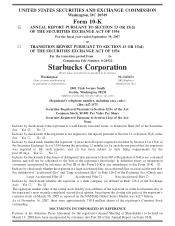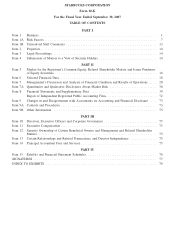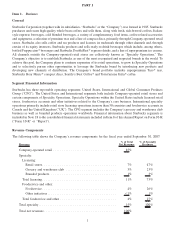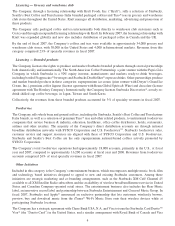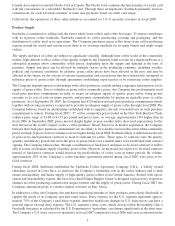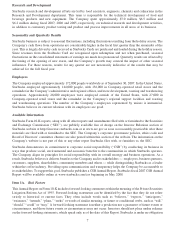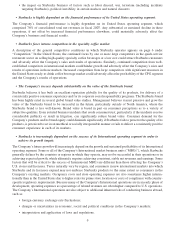Starbucks 2007 Annual Report Download - page 10
Download and view the complete annual report
Please find page 10 of the 2007 Starbucks annual report below. You can navigate through the pages in the report by either clicking on the pages listed below, or by using the keyword search tool below to find specific information within the annual report.to update or alter any forward-looking statements, whether as a result of new information, future events or
otherwise. These forward-looking statements are all based on currently available operating, financial and com-
petitive information and are subject to various risks and uncertainties. The Company’s actual future results and
trends may differ materially depending on a variety of factors, including, but not limited to, the risks and
uncertainties discussed below. The risks below are not the only ones the Company faces. Additional risks and risks
that management currently considers immaterial may also have an adverse effect on the Company.
•Failing to meet market expectations for Starbucks financial performance could cause the market price
of Starbucks stock to drop rapidly and sharply.
Management believes the price of Starbucks stock reflects high market expectations for the Company’s future
operating results. Any failure to meet those expectations, particularly for the growth rates for (i) comparable store
sales attributable to number of transactions, average value per transaction, or both, (ii) net revenues, (iii) earnings
per share or (iv) net new store openings could cause the market price of Starbucks stock to drop rapidly and sharply.
•Starbucks is subject to a number of significant risks that might cause the Company’s actual results to
vary materially from its forecasts, targets, or projections, including:
• lower customer traffic or average value per transaction, which negatively impacts comparable store sales, net
revenues, operating income and earnings per share, due to:
• the impact of initiatives by competitors and increased competition generally;
• lack of customer acceptance of price increases necessary to cover costs or new products;
• unfavorable general economic conditions in the markets in which Starbucks operates, including, but not
limited to, downturns in the housing market, higher interest rates, higher unemployment rates, lower
disposable income due to higher energy or other consumer costs, lower consumer confidence, and other
events or factors that adversely affect consumer spending;
• declines in general consumer demand for specialty coffee products; or
• adverse impacts due to negative publicity regarding the Company’s business practices or the health effects
of consuming its products;
• cost increases that are either wholly or partially beyond the Company’s control, such as:
• commodity costs for commodities that cannot be effectively hedged, such as fluid milk, and to a lesser
extent, high quality arabica coffee;
• labor costs such as increased health care costs, general market wage levels and worker’s compensation
insurance costs;
• construction costs associated with new store openings;
• information technology costs and other logistical resources necessary to maintain and support the global
growth of the Company’s business; and
• litigation against Starbucks, particularly class action litigation;
• delays in store openings for reasons beyond the Company’s control, or a lack of desirable real estate
locations available for lease at reasonable rates, either of which could keep the Company from meeting
annual store opening targets and, in turn, negatively impact net revenues, operating income and earnings per
share;
• any material interruption in the Company’s supply chain beyond its control, such as (i) material interruption
of roasted coffee supply due to the casualty loss of any of the Company’s roasting plants or the failures of
third-party suppliers, or (ii) interruptions in service by common carriers that ship goods within the
Company’s distribution channels; and
8

